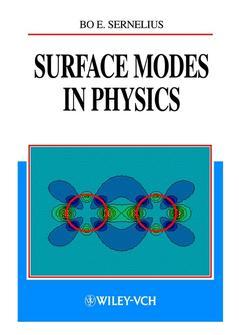Description
Surface Modes in Physics
Author: SERNELIUS B. E.
Language: English
Approximative price 165.11 €
Subject to availability at the publisher.
Add to cart
Publication date: 06-2001
370 p. · 24.5x17.8 cm · Hardback
370 p. · 24.5x17.8 cm · Hardback
Description
/li>Contents
/li>
Electromagnetic surface modes are present at all surfaces and interfaces between material of different dielectric properties. These modes have very important effects on numerous physical quantities: adhesion, capillary force, step formation and crystal growth, the Casimir effect etc. They cause surface tension and wetting and they give rise to forces which are important e.g. for the stability of colloids. This book is a useful and elegant approach to the topic, showing how the concept of electromagnetic modes can be developed as a unifying theme for a range of condensed matter physics. The author concentrates in finding out the basic origin of the force and how they are developed from the collective excitations of the solids. Different materials are treated, e.g. metals, semiconductors, plasmas, liquids and gases all with different collective modes. In close relation to the theoretical background, the reader is served with a broad field of applications. The book serves readers who are concerned with applications to real world problems with a deep knowledge on surface modes, and inspires new developments of the field.
Introduction
1 Bulk modes
1.1 Bulk modes in terms of fields
1.2 Bulk modes in terms of potentials
2 Model dielectric functions
2.1 Lorentz' classical model for the dielectric function of insulators
2.2 Drude's classical model for the dielectric function of metals
2.3 Modelling
2.4 Dielectric function of a plasma
2.5 Static dielectric function for a dilute gas of permanent dipoles
2.6 Debye rotational relaxation
2.7 Dielectric properties of water
2.8 Superluminal speeds
3 Zero point energy of modes
4 Modes at flat interfaces
4.1 Modes at a single interface
4.2 Modes in slab geometry
4.3 The Casimir effect
4.4 Metal surfaces
4.5 Quantum wells
5 Forces
5.1 Two molecules with permanent dipole moments
5.2 One ion and one molecule with permanent dipole moment
5.3 Two molecules one with and one without permanent dipole moment
5.4 Two molecules without permanent dipole moments
5.5 Two ions
5.6 Three or more polarizable atoms
5.7 Ineraction between macroscopic objects
5.8 Interaction between two spheres: limiting results
5.9 Interaction betweeen two spheres: general results
5.10 Gernal expression for small separations
5.11 Cylinders and half spaces
5.12 Summation of pair interactions
5.13 Derivation of the van der Waals equations of state
6 Energy and force
6.1 Interaction energy at zero temperature
6.2 Interaction energy at finite temperature
6.3 Surface energy, method 1: no retardation
6.4 Surface energy, method 1: retardation
6.5 Surface energy, method 2: no retardation
6.6 Surface energy, method 2: retardation
6.7 Finite temperatures
6.8 Recent results for metals
6.9 Adhesion, cohersion, and wetting
6.10 Finding the pair interactions
7 Modes at non planar interfaces
7.1 Modes at the surface of a sphere
7.2 Modes at the surface of a cylinder
7.3 Modes at an edge
7.4 Modes in a needle (a paraboloid of revolution)
8 Different mode types
8.1 Polar semiconductors or ionic insulators
8.2 Metallic systems
8.3 Characterization of different surface mode types
8.4 Spatial dispersion
8.5 Surface roughness
8.6 The ATR method
8.7 Earthquakes, rainbow and optical glory
9 Colloids
9.1 Milk
9.2 Stability of colloids
9.3 Formation of the double layer
9.4 Gouy and Chapman theory
9.5 Stern's theory of a flat double layer
9.6 The ZETA potential
9.7 Interaction energy and force between objects with double layers
Appendix 1 Conversion table from CGS to SI units
Appendix 2 Fourier transform conventions
1 Bulk modes
1.1 Bulk modes in terms of fields
1.2 Bulk modes in terms of potentials
2 Model dielectric functions
2.1 Lorentz' classical model for the dielectric function of insulators
2.2 Drude's classical model for the dielectric function of metals
2.3 Modelling
2.4 Dielectric function of a plasma
2.5 Static dielectric function for a dilute gas of permanent dipoles
2.6 Debye rotational relaxation
2.7 Dielectric properties of water
2.8 Superluminal speeds
3 Zero point energy of modes
4 Modes at flat interfaces
4.1 Modes at a single interface
4.2 Modes in slab geometry
4.3 The Casimir effect
4.4 Metal surfaces
4.5 Quantum wells
5 Forces
5.1 Two molecules with permanent dipole moments
5.2 One ion and one molecule with permanent dipole moment
5.3 Two molecules one with and one without permanent dipole moment
5.4 Two molecules without permanent dipole moments
5.5 Two ions
5.6 Three or more polarizable atoms
5.7 Ineraction between macroscopic objects
5.8 Interaction between two spheres: limiting results
5.9 Interaction betweeen two spheres: general results
5.10 Gernal expression for small separations
5.11 Cylinders and half spaces
5.12 Summation of pair interactions
5.13 Derivation of the van der Waals equations of state
6 Energy and force
6.1 Interaction energy at zero temperature
6.2 Interaction energy at finite temperature
6.3 Surface energy, method 1: no retardation
6.4 Surface energy, method 1: retardation
6.5 Surface energy, method 2: no retardation
6.6 Surface energy, method 2: retardation
6.7 Finite temperatures
6.8 Recent results for metals
6.9 Adhesion, cohersion, and wetting
6.10 Finding the pair interactions
7 Modes at non planar interfaces
7.1 Modes at the surface of a sphere
7.2 Modes at the surface of a cylinder
7.3 Modes at an edge
7.4 Modes in a needle (a paraboloid of revolution)
8 Different mode types
8.1 Polar semiconductors or ionic insulators
8.2 Metallic systems
8.3 Characterization of different surface mode types
8.4 Spatial dispersion
8.5 Surface roughness
8.6 The ATR method
8.7 Earthquakes, rainbow and optical glory
9 Colloids
9.1 Milk
9.2 Stability of colloids
9.3 Formation of the double layer
9.4 Gouy and Chapman theory
9.5 Stern's theory of a flat double layer
9.6 The ZETA potential
9.7 Interaction energy and force between objects with double layers
Appendix 1 Conversion table from CGS to SI units
Appendix 2 Fourier transform conventions
© 2024 LAVOISIER S.A.S.




